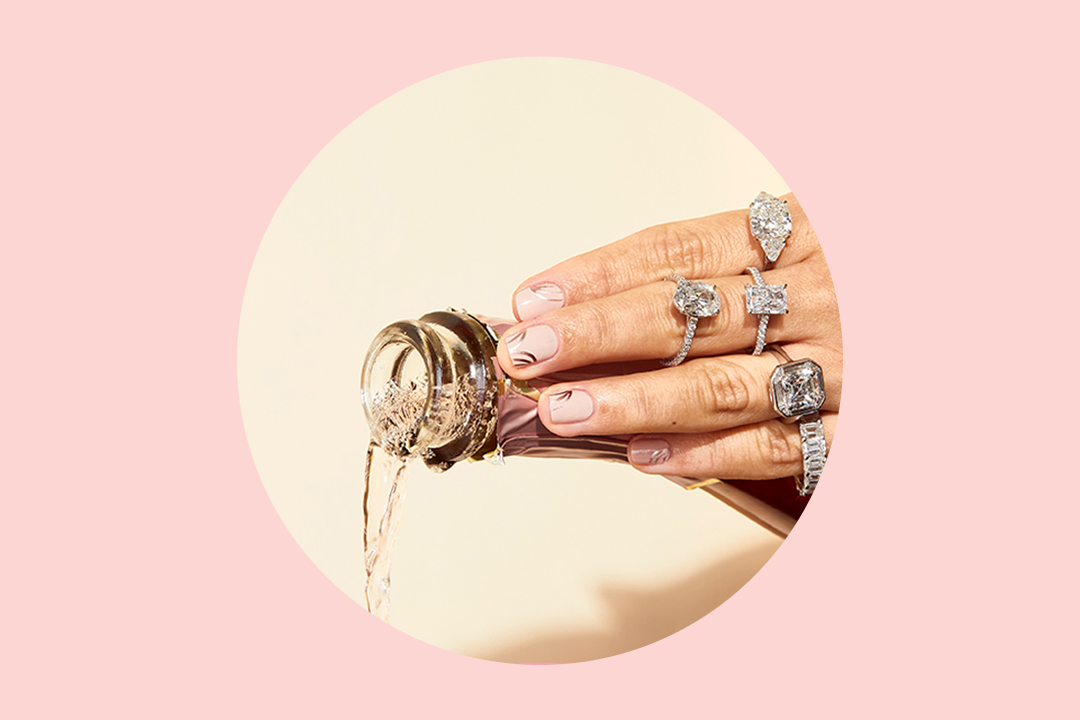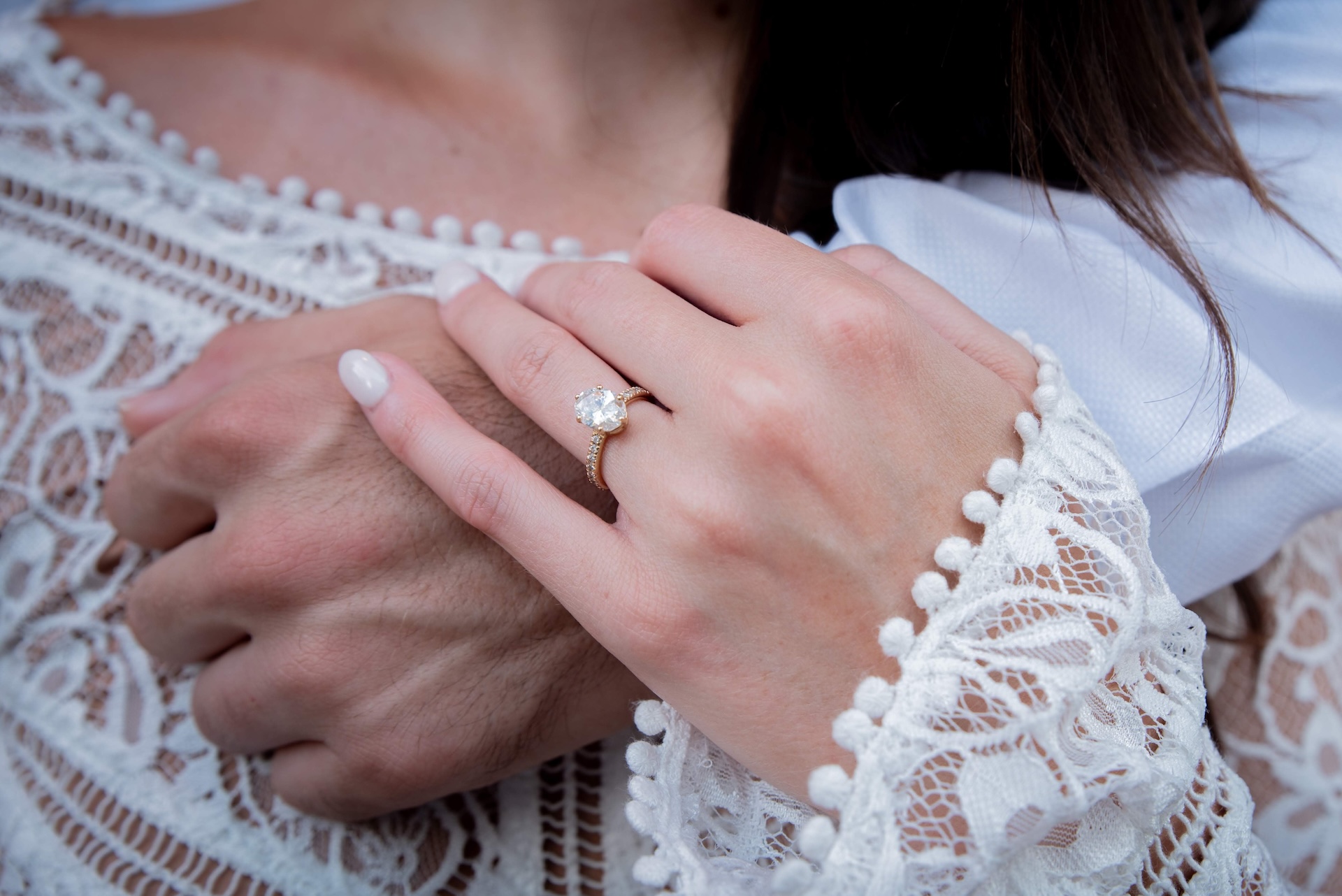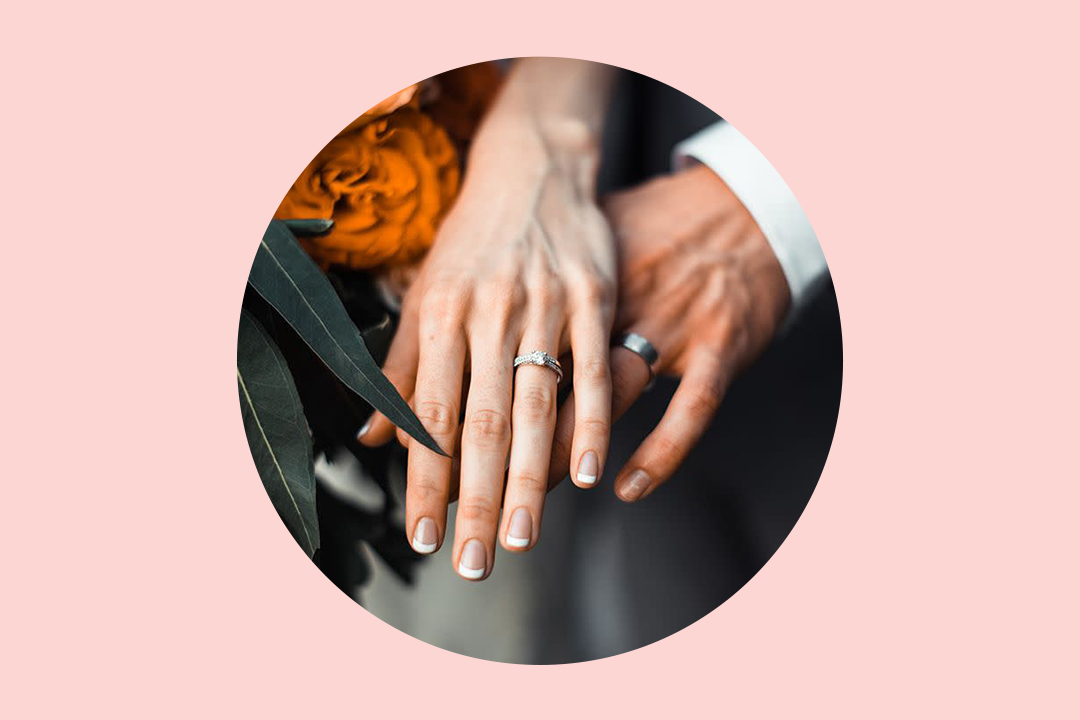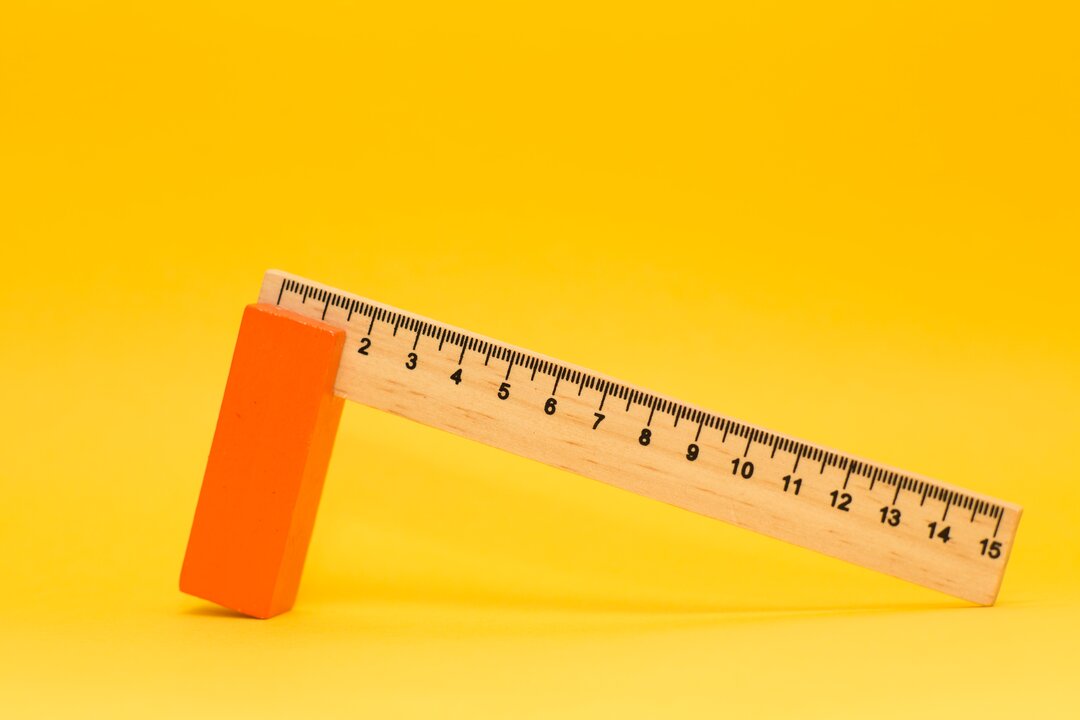- Expert advice/
- Wedding planning 101/
- Rings/
- How Much Do Wedding Rings Cost? Average Price Breakdown
- Rings
How Much Do Wedding Rings Cost? Average Price Breakdown
Average cost of wedding ring: men’s bands average $600 and women’s average $1,400, with rings ranging from $100 to $5,000.
Last updated October 6, 2025

- Wedding rings cost anywhere from hundreds to tens of thousands, but most couples spend around $1,500 total for both partners’ wedding bands.
- Three main factors drive ring prices: the metal type (platinum costs most, gold is popular, alternative metals save money), gemstone choices (which create the biggest price variations), and design complexity (simple solitaires cost less than elaborate custom work)
- Smart shopping strategies can save significant money including choosing 14k gold over platinum, considering lab-grown diamonds that cost 40-60% less, and timing purchases around sales periods like Black Friday.
- Focus on what fits your budget and relationship - beautiful, meaningful rings exist at every price point, and the right amount depends on your financial situation and priorities
Shopping for wedding rings feels overwhelming when you're staring at price tags that range from hundreds to tens of thousands of dollars. This breakdown covers everything you need to know about wedding ring costs to the factors that drive pricing. You'll learn smart shopping strategies, timing tips, and how to find rings that fit both your style and budget without the stress.
What's the Average Cost of Wedding Rings?
Wedding rings cost anywhere from a few hundred to tens of thousands of dollars, but most couples spend an average of around $1,500 for both wedding rings.
These price ranges might seem overwhelming at first, but here's what makes this easier to navigate. Beautiful, meaningful rings exist at every budget level, and the "right" amount to spend depends entirely on your financial situation and priorities.
Average engagement ring cost
Engagement ring costs represent the largest portion of most couples' ring budget. The national average sits around $5,200, according to recent industry data but this doesn't capture the full picture.
Many couples spend significantly less than this average. About one in five couples keeps their engagement ring budget under $2,500, while others invest $8,000 or more for larger stones or designer settings. Your engagement ring will likely feature a center stone, which explains why it typically costs more than wedding bands.
Average wedding band cost
Wedding bands serve a different purpose than engagement rings and typically cost less. Most couples spend between $400 and $1,800 per ring, with the total for both partners averaging around $1,500.
Men's wedding bands generally cost between $400 and $1,000, focusing on durability and comfort for daily wear. Women's wedding bands range from $600 to $1,800. They often feature complementary design elements, like small diamonds or detailed metalwork, that pair with the engagement ring.
These rings prioritize longevity. You'll wear them every day for decades, so many couples invest in quality metals and craftsmanship even if they choose simpler designs.
Wedding ring costs by popular styles
Understanding different style categories helps you set realistic budget expectations:
- Simple metal bands: Range from $150 to $700 per ring, perfect for couples who prefer minimalist aesthetics or want to prioritize other wedding expenses
- Diamond-accented bands: Cost between $700 and $2,500 per ring, featuring smaller stones that beautifully complement engagement rings
- Vintage-inspired designs: Typically $800 to $2,000 per ring, incorporating intricate details like milgrain edges, filigree work, or art deco patterns
- Alternative metal options: Range from $200 to $800 per ring, using materials like tungsten, titanium, or even wood for modern, unique looks
- Matching bridal sets: Cost $2,000 to $6,000 for engagement ring and wedding band combinations designed to work together perfectly
What Makes Wedding Rings More Expensive?
Three primary factors determine wedding ring costs: the metal you select, any gemstones included, and the complexity of the design. Understanding how each element impacts pricing helps you make informed decisions that align with both your style preferences and budget constraints.
Even small changes in these areas can dramatically affect your final cost. For example, switching from platinum to white gold might save you several hundred dollars per ring without significantly changing its appearance.
Metal type affects durability and cost
Your choice of metal forms the foundation of both your ring's cost and its longevity. Different metals offer distinct advantages and price points.
- Platinum: The most premium and durable choice, typically adding $800 to $1,500 to each ring's cost compared to gold options. This premium reflects platinum's exceptional durability, hypoallergenic properties, and natural white color that won't fade over time. For couples with sensitive skin or active lifestyles, the extra cost often proves worthwhile.
- Gold: The most popular choice for wedding bands, available in multiple purities and colors. 18k gold costs more than 14k gold but offers richer color and greater purity. 14k gold provides the sweet spot for many couples, offering excellent durability at more accessible prices. White, yellow, and rose gold all cost similarly within the same karat weight.
- Alternative Metals: Titanium, tungsten, and even ceramic offer modern looks at budget-friendly prices. These materials appeal to couples seeking unique looks or those with metal allergies. However, some alternative metals can't be resized, which might influence your decision.
Gemstone choices create big price variations
While a large center stone is the hallmark of an engagement ring, adding smaller gemstones to a wedding band is a popular way to add brilliance and personality. Your decision to include stones, and how many, is one of the biggest factors in the ring's final cost.
- Diamond Bands: The most common choice is a diamond band. The cost is driven by the total carat weight of all the small diamonds combined, not a single stone's "4 Cs."
- A pavé or channel-set band with diamonds covering the top half of the ring offers significant sparkle at a moderate price increase.
- An eternity band, with diamonds encircling the entire ring, represents the most luxurious and expensive option, often costing thousands more than a plain band due to the sheer number of stones required.
- Lab-Grown vs. Natural Diamonds: Just as with engagement rings, opting for lab-grown diamonds for your wedding band can offer savings of 40 to 60 percent compared to natural diamonds of the same size and quality. This makes a style like an eternity band much more attainable.
- Alternative Gemstones: Using colored gemstones like sapphires or rubies as accent stones can create a unique, meaningful look. They can be set alternating with diamonds or on their own, often providing a more budget-friendly way to add color and detail.
“9% of couples are integrating colored gems as a way to mix it up or add some personality into their rings” - Emily Forrest, Head of Communications for Zola
Design complexity adds artistic value and cost
The level of detail and craftsmanship in your wedding band significantly influences the final price. Simple, classic designs require less labor, while intricate features add to the cost.
- Plain Bands: A classic, unadorned metal band is the most straightforward and cost-effective option. Its price is determined almost entirely by the metal chosen. Styles like comfort-fit or flat-fit offer different feels without a major impact on cost.
- Intricate Details: Features that require more skilled labor will increase the price. Details like milgrain edging, hand-engraved patterns, filigree work, or a "rope" design can add several hundred dollars to the ring's cost. Mixed-metal or two-tone designs also require more work and command higher prices.
- Contoured Bands: If the wedding ring needs to curve or "contour" to fit snugly against your engagement ring, this customization requires precise work and will cost more than a simple, straight band.
- Custom Design Work: Creating a completely custom band commands the highest premiums, often doubling the cost of a similar pre-made ring. However, this allows you to craft a one-of-a-kind piece that perfectly complements your engagement ring and personal style.
- Brand Premiums: Designer names and luxury brands often charge 50 to 200 percent more than local jewelers or online retailers for comparable quality and design elements.
How Much Should You Actually Spend?
Today's couples approach ring budgets more holistically, considering their overall financial picture and life goals. Your ring budget should feel comfortable within your broader financial context. Consider your other major expenses and savings goals when determining how much to spend.
Communication with your partner about expectations helps avoid misunderstandings or financial stress. Some couples prefer modest rings to allocate more money toward experiences like wedding add-ons, honeymoons, or home down payments. Others view rings as heirloom pieces worth significant investment.
- Budget realistically: Choose an amount that won't create financial strain or require debt
- Consider timeline: Factor in engagement length when planning your purchase timing
- Think long-term: Remember you'll wear these rings for decades, not just special occasions
- Stay flexible: Beautiful options exist at every price point, so don't feel pressured to spend beyond your means
Smart Ways to Save on Wedding Rings
Savvy couples can find significant savings without sacrificing beauty or quality. These strategies help you maximize your ring budget and get more value from every dollar spent.
Be Strategic with Gemstones. If you love the sparkle of a diamond band, you still have options.
- Opt for a "half-eternity" style with stones across the top half of the ring instead of a full-eternity band. It provides the same look from above for a fraction of the cost.
- Choose lab-grown diamonds over natural diamonds. They are chemically and visually identical but can save you 40-60%, making a diamond band much more affordable.
Choose Your Metal Wisely. The metal is a major cost factor. Opting for 14k gold instead of platinum can save you hundreds of dollars per ring with a nearly identical look, especially for white metals.
Keep the Design Simple. Intricate details like hand-engraving or milgrain edging add labor costs. A classic, unadorned band is timeless and the most budget-friendly choice. You can always add an engraved message on the inside for a personal touch without the high cost.
Consider Buying a Matching Set. Many jewelers offer a discount if you purchase the engagement ring and both wedding bands from them at the same time. This can lead to significant savings and ensures the rings are designed to fit together perfectly.
Shop Around and Time Your Purchase. Don't buy from the first place you visit.
- Compare prices from local jewelers, major retailers, and online stores. Online retailers often have lower prices due to less overhead.
- Look for sales around holidays like Black Friday, Christmas, and Valentine's Day, when jewelers offer their best promotions.
Where and When to Buy Wedding Rings
Strategic timing and retailer selection significantly impact your final ring costs. Understanding seasonal patterns and different seller types helps you find the best value for your budget.
The jewelry market follows predictable seasonal trends that savvy couples can use to their advantage. Holiday periods offer the deepest discounts as retailers compete for gift buyers. Valentine's Day promotions specifically target engagement ring shoppers with special financing or bundled deals.
Online retailers dominate the modern ring market for good reason. Lower overhead costs translate to competitive pricing, often 20 to 30 percent less than traditional jewelry stores. Online shopping also provides access to detailed specifications, customer reviews, and easy price comparison tools.
However, online purchases require careful attention to return policies, sizing services, and customer support quality. Reputable online jewelers offer generous return periods and free resize services to address these concerns.
Local jewelers provide personalized service and immediate gratification that online shopping can't match. You can see rings in person, get professional sizing, and often negotiate pricing, especially when purchasing multiple pieces. Local jewelers also offer ongoing services like cleaning, maintenance, and future upgrades.
Estate sales and vintage dealers offer unique pieces with character and history. Vintage rings often cost less than new pieces of comparable quality, though they may require restoration or resizing. This option appeals to couples seeking one-of-a-kind pieces with environmental benefits.
Start your ring shopping at least two to three months before you need the final pieces. This timeline allows for proper sizing, potential customizations, and any needed adjustments without rushing your decision or paying expedited fees.
Custom rings require even longer lead times, often four to six months from initial consultation to final delivery. Plan accordingly if you're designing something unique or working with specialized craftspeople.
Research your local market conditions before setting budget expectations. Major metropolitan areas typically command higher prices than smaller cities, while tourist destinations often inflate pricing for luxury goods like jewelry.
Planning Your Ring Purchase Timeline
Successful ring shopping requires strategic timing and realistic expectations about the process. Understanding typical timeframes helps you avoid rush fees and ensures you get exactly what you want.
Research phase should begin three to six months before you need the rings. Use this time to educate yourself about different options, visit multiple retailers, and determine your budget parameters.
Shopping and selection typically takes four to eight weeks once you begin seriously evaluating options. Allow time to visit multiple jewelers, compare prices, and potentially order custom pieces or special sizes. Rush decisions often lead to buyer's remorse or settling for less than ideal options.
Production and delivery varies significantly based on your choices. Ready-made rings might be available immediately or within a few days. Custom pieces, resizing, or special orders often require four to eight weeks. International shipping or specialty items may take even longer.
Final preparations including professional cleaning, final sizing checks, and insurance appraisals should happen in the week before you need the rings. This buffer time addresses any last-minute issues without panic or stress.
Consider seasonal factors that might affect your timeline. Wedding season and holiday periods can extend production times as jewelers face higher demand. Summer and fall weddings create predictable busy periods when services may take longer than usual.
Start Your Perfect Ring Journey
Your ideal wedding rings should make you smile every time you look at them, regardless of their price tag or how they compare to others' choices. Focus on finding pieces that reflect your personal style, fit comfortably in your budget, and represent your unique love story.
Ready to plan every detail of your dream wedding celebration? You can track your spending with our free budget tracker, which helps you allocate funds and stay on top of payment due dates. Or explore our curated selection of wedding vendors and services to bring your vision to life.
Your Wedding Ring Questions Answered
Is twenty thousand dollars a lot for wedding rings?
This amount represents a luxury purchase well above national averages and works best for couples with substantial disposable income and few competing financial priorities.
Is ten thousand dollars enough for wedding rings?
This budget provides excellent options for high-quality rings with beautiful stones, premium metals, and sophisticated settings from reputable jewelers or designers.
Is five thousand dollars enough for wedding rings?
This amount aligns closely with national spending patterns and offers many beautiful choices for wedding rings with quality diamonds or stones, premium metals, or elegant settings that will last a lifetime.
What makes engagement rings cost more than wedding bands?
Engagement rings typically feature prominent center stones that account for most of the cost, while wedding bands focus on durable metals and simpler designs meant for daily wear over decades.
Should both partners wear wedding bands after the ceremony?
While traditionally both partners wear bands after the wedding, modern couples choose what works for their lifestyle and relationship. Some prefer matching sets, others may opt for alternatives such as tattoos, and some skip bands entirely for practical or personal reasons.
Up next for you

Where You Can (and Can't) Wear Your Engagement Ring
Inspiration
Diamond experts share all the places you can wear your engagement ring and where you shouldn't wear your ring. Plus, tips for keeping your engagement ring like new.

Is Engagement Ring Insurance Worth It?
Inspiration
Engagement ring insurance is an easy way to achieve peace of mind and keep your jewelry safe. How much does it cost? Do you need it? And, if so, where can you find the best policy? We've got the answers.

Specialty Jewelry Insurance Vs. Protection Plans: What Do I Need?
Advice
Want to know the difference between a protection plan and jewelry insurance? Learn what coverage is right for you to keep your wedding rings and other jewelry safe and secure.

The Ultimate Diamond Carat Size Guide
How-To
New to the world of wedding ring shopping? Find out everything you need to know with our diamond carat size guide from Zola.
- Expert advice/
- Wedding planning 101/
- Rings/
- How Much Do Wedding Rings Cost? Average Price Breakdown
Find even more wedding ideas, inspo, tips, and tricks
We’ve got wedding planning advice on everything from save the dates to wedding cakes.
